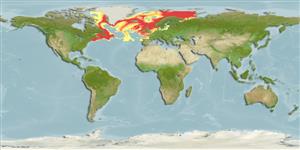Preferred temperature (Referencia
123201): 0.6 - 10.3, mean 5.6 °C (based on 824 cells).
Phylogenetic diversity index (Referencia
82804): PD
50 = 0.5625 [Uniqueness, from 0.5 = low to 2.0 = high].
Bayesian length-weight: a=0.00646 (0.00554 - 0.00753), b=3.06 (3.02 - 3.10), in cm total length, based on LWR estimates for this species (Ref.
93245).
Nivel trófico (Referencia
69278): 4.1 ±0.0 se; based on diet studies.
Generation time: 13.1 (8.8 - 14.5) years. Estimated as median ln(3)/K based on 12
growth studies.
Resiliencia (Referencia
120179): Bajo, población duplicada en un tiempo mínimo de 4.5-14 años (rm=0.43; K=0.06-0.12; tm=2-11; tmax=30; Fec=50,000).
Prior r = 0.19, 95% CL = 0.12 - 0.28, Based on 2 full stock assessments.
Fishing Vulnerability (Ref.
59153): High to very high vulnerability (66 of 100).
🛈
Climate Vulnerability (Ref.
125649): Moderate to high vulnerability (46 of 100).
🛈
Nutrients (Ref.
124155): Calcium = 19.2 [7.5, 32.8] mg/100g; Iron = 0.214 [0.105, 0.410] mg/100g; Protein = 17.1 [15.7, 18.5] %; Omega3 = 0.407 [0.194, 0.867] g/100g; Selenium = 31.2 [15.1, 68.7] μg/100g; VitaminA = 8.07 [1.81, 36.72] μg/100g; Zinc = 0.336 [0.224, 0.512] mg/100g (wet weight);
